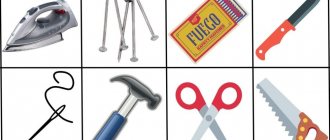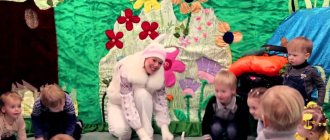Life safety games in the preparatory group
Children of the 7th year of life already have a certain amount of knowledge on life safety. At this age, it becomes important to consolidate acquired knowledge and skills. The child must consciously have a positive attitude towards compliance with safety rules. The game will still be one of the most successful methods of conveying the necessary information. Didactic games are already becoming more complicated and require more attentiveness and perseverance. Role-playing games enable the child to make his own choices in the game, thereby showing his attitude to current situations. Children in older preschool age are still very active. Therefore, conducting outdoor games will be as interesting as in earlier periods.
In the pre-school group:
continue to teach ecological culture, begin to get acquainted with the Red Book and some species of plants and animals listed in it; introduce new elements of the city’s infrastructure (square, boulevard); improve knowledge of traffic rules, raise awareness of the need to comply with them; expand navigation skills - know the way from home to kindergarten and back; teach responsibility and caution when using household appliances and equipment; reinforce the rules of behavior during gaming activities; clarify knowledge of emergency phone numbers; continue to teach careful behavior with strangers, train safe action skills; clarify the ability to give your first name, last name, address, telephone number in the necessary cases.
Team game on life safety “Experts” in the preparatory group
In the school preparatory group, the material covered is summarized and there is the opportunity to conduct quiz games on several topics
Children 6–7 years old are able to systematize acquired knowledge. Therefore, it would be appropriate to hold a quiz game that will combine various areas of the basics of safe behavior: fire safety, rules of behavior on the road, behavior at home. Let's give an example of a summary of the quiz game “Connoisseurs”, compiled by teacher O.A. Vordova.
Children are divided into 2 teams, a captain is chosen, and you can come up with a motto for each team.
Progress of the game
Each exercise is performed for 2-3 minutes. Children in pairs sit opposite each other
at arm's length.
Educator. Close your eyes, reach out towards each other
hands to each other, “get to know each other”
with one hand. Try to get to know yours better
neighbor Put your hands down. Stretch your hands forward, find your neighbor’s hands - “your hands
are quarreling." Put your hands down. Your hands are looking for each other - “they want to make peace”
Your hands make peace, they ask for forgiveness, you part as friends.
After playing with the children, discuss what form of behavior the partner liked
more, what feelings arose during the exercise.
Card No. 21
Help yourself
Exercise game
Target. Teach children techniques to help relieve emotional stress.
Card index with the goals of games on life safety in the preparatory group
The life safety card file in the preparatory group for the Federal State Educational Standard, with the aim of consolidating the material studied in previous years, is aimed at generalizing and systematizing knowledge and the ability to avoid life-threatening situations. Board games, creative tasks, joint activities, conversations and game situations are suitable for this. The card file with the goals of games on life safety in the preparatory group is aimed at solving the following tasks:
It is important for future first-graders to be able to behave on the street and in transport; be able to cross the road correctly; know and follow the traffic rules for pedestrians. By the end of kindergarten, children should have formed habits that promote a healthy lifestyle and personal hygiene; Self-care skills must be developed. Children are instilled with a caring attitude towards health and are taught a negative attitude towards actions that can cause harm to the body. A child of senior preschool age must have a clear understanding of household items that pose a danger and know fire safety rules. At the age of 6-7 years, a child needs to have clear ideas about behavior in public places, the ability to build relationships with other people, and be polite and well-mannered.
Stranger
Important! Pay special attention to the possible consequences of meeting and communicating with unknown or unfamiliar people
The importance of games on the basics of safety in preschool educational institutions
Danger can lurk for anyone anywhere. Adults have already developed a certain model of behavior in life-threatening situations. Young children are the most vulnerable in such moments. The task of adults is to tell children in as much detail and as clearly as possible about the dangers that exist in the world, how to avoid them, and what is the best thing to do if they do occur. At home, the child receives the first knowledge about possible safety-threatening situations from his parents. Kindergarten workers should expand this knowledge and instill skills of correct behavior in unexpected situations. Preschoolers need a special approach
They need to convey very complex issues, show the importance of knowing safety rules and encourage them to remember them. The main activity of children is play
The information presented in the game is easier to convey to the child, and it is also convenient to visually show and act out actions to prevent or alleviate unsafe phenomena in life.
Danger can lie in wait for a child anywhere.
The goals of the games will be to expand the concepts of possible warning dangers at home, in nature, in communication with people, on the street, including on the road, to instill a model of safe behavior and to gain the skills of correct action in the event of an adverse event.
All possible dangers can be generalized into several categories:
- natural hazards (animal and insect bites, poisonous berries and mushrooms, thunderstorms, ice, etc.);
- troubles arising from people (robbers, kidnappers, fights);
- threats in the home (electrical appliances, sharp objects);
- fire hazard;
- dangers on the street (traffic);
- threat to health (failure to comply with personal hygiene rules, improper handling of medications).
Card index with the goals of games on life safety in the middle group
Didactic games on safety in the middle group and pupils of junior groups largely come down to an initial acquaintance with new concepts.
The children receive information by “traveling” through magical lands, meeting their favorite cartoon characters and fairy-tale characters there. We must remember! A distinctive feature of four-year-old students is pronounced motor activity.
This quality is important to use in the teaching process. Some of the material should be presented in the form of finger games, round dance movements, physical education minutes
This prevents the child from losing interest and attentiveness.
Finger game
Life safety games in the second junior group
Children of the second younger group retain the study of objects based on sensations and sensory perception. Therefore, tactile contact with the material being studied is also important. In addition, children are of great interest in interacting with people, especially with their peers. Joint play is being mastered. In this regard, role-playing games will be very useful. Main tasks for the period of the second junior group:
- continue to master ideas about the natural world and interactions in it: do not pick flowers and herbs, do not litter in the forest, do not touch other people’s animals;
- study the structure of the roadway, introduce the concept of a sidewalk, zebra crossing, teach the necessary behavior near the road, hold the hand of adults, introduce the concept of a yellow traffic light warning signal and road signs;
- increase knowledge about household hazards;
- expand knowledge about the rules of safe behavior indoors: open the door using the door handle, go down the stairs holding the railing);
- teach correct behavior during games: do not throw sand, do not swallow objects, do not taste toys, etc.;
- learn to ask adults for help in emergency situations.
Children 3–4 years old are very active and it is difficult for them to focus their attention on one thing for a long time. It is relevant to conduct outdoor games, exciting role-playing situations, as well as simple didactic games
When analyzing different situations using game actions, children gain initial skills in behavior in an unfamiliar place (training game “I’m Lost”), in public transport (game “Bus”), etc.
In the second younger group, children are introduced to the yellow traffic light
Conducting the didactic game “Good and Evil Fire” in the second junior group
The objectives of the game will be:
- teach children to distinguish between “bad” and “good” fire;
- teach the rules of safe behavior at home;
- develop mindfulness.
To play the game you will need a playing field divided into 2 halves (“good” and “evil” fire) and a set of pictures depicting various situations with the presence of fire.
The game involves from 2 to 6 children. The cards need to be laid out face down on the table. Children take turns coming to the table and taking one card. You need to place it on the desired half of the playing field.






